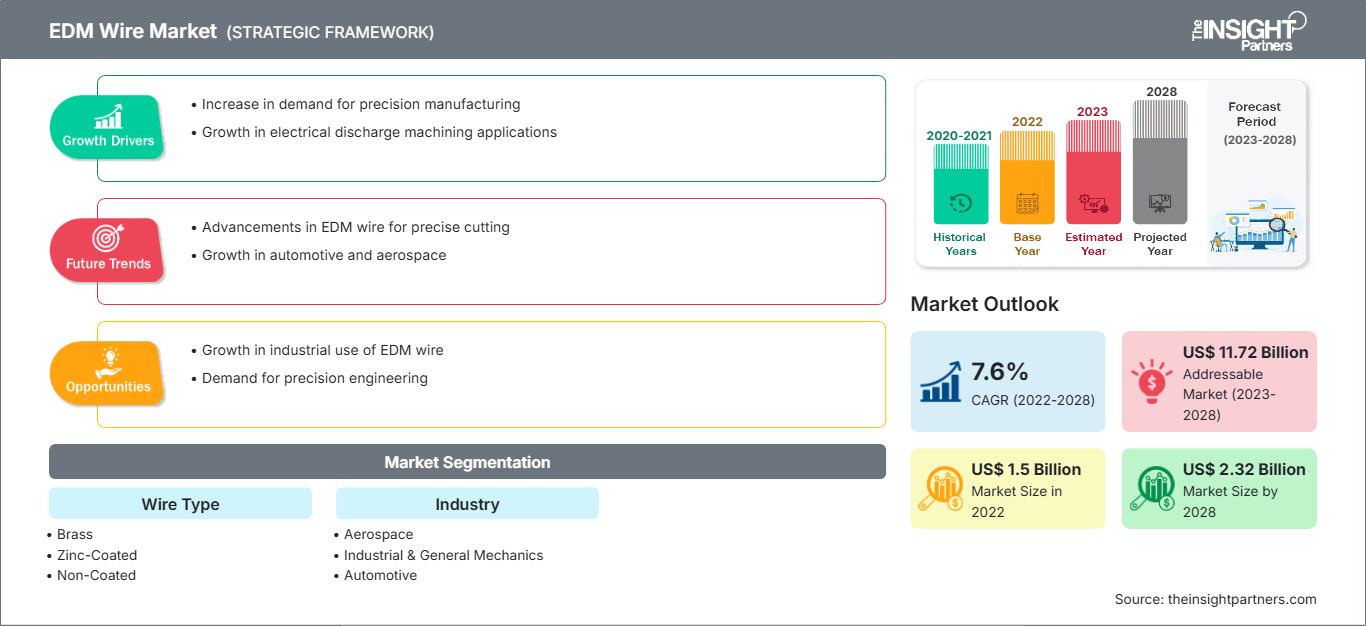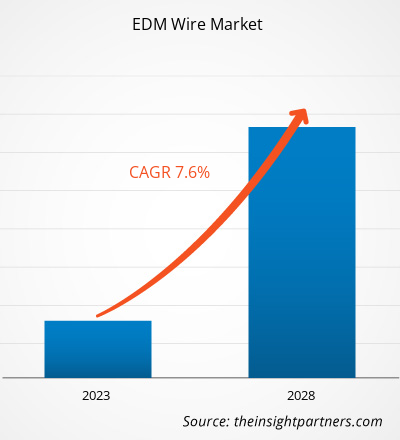Si prevede che il mercato dei fili per elettroerosione a elettrodo crescerà da 1.497,50 milioni di dollari nel 2022, con un CAGR del 7,6% dal 2022 al 2028.
L'industria automobilistica è in costante crescita in Nord America e ha un impatto enorme sull'economia nazionale. Questo settore rappresenta circa il 3% del PIL nazionale degli Stati Uniti. Un settore così ben posizionato necessita costantemente di forniture e componenti per motori, telai e altri elementi metallici per auto, il che indica l'elevata domanda da parte dei produttori di macchine utensili. I fili per elettroerosione a elettrodo vengono utilizzati per varie applicazioni di stampi metallici, come lo stampaggio di fari in acciaio, in questo settore. I produttori preferiscono utilizzare le procedure di elettroerosione a elettrodo per lo stampaggio e la foratura di componenti automobilistici di grandi dimensioni. Inoltre, si prevede che le iniziative governative volte a incoraggiare gli investimenti nel settore automobilistico aumenteranno la domanda di fili per elettroerosione a elettrodo nei prossimi anni. Secondo The Frontier Hub, gli investimenti diretti esteri (IDE) nell'industria automobilistica statunitense hanno raggiunto i 114,6 miliardi di dollari nel 2018. Inoltre, nell'agosto 2021, il governo degli Stati Uniti ha firmato un ordine esecutivo che fissa un nuovo obiettivo del 50% di quota di vendita di veicoli elettrici entro il 2030. Il governo ha inoltre stanziato 3 miliardi di dollari per sostenere l'industria nazionale dei veicoli elettrici. In linea con questo piano, GM ha annunciato un investimento di 35 miliardi di dollari e Ford di 30 miliardi di dollari nel 2025 per rilanciare il settore automobilistico. Inoltre, l'aumento della domanda di arredamento, elettrodomestici ed elettronica di consumo, compresi elettrodomestici da cucina intelligenti ed efficienti, con molte persone che si trasferiscono in periferie in via di sviluppo e in evoluzione, alimenta la crescita del mercato dei fili per elettroerosione a filo nella regione.
Diversi produttori di aeromobili militari e commerciali hanno una presenza significativa in Nord America, il che lo rende il più grande mercato aerospaziale al mondo. Secondo l'Aerospace Industries Association (AIA), l'industria aerospaziale rappresenta l'1,8% del PIL totale degli Stati Uniti, contribuendo al PIL per 382 miliardi di dollari. L'industria aerospaziale in Nord America ha prosperato grazie alle prospettive positive verso l'adozione di nuove tecnologie, alla presenza di una forza lavoro qualificata, a politiche economiche favorevoli e a un PIL pro capite elevato nelle principali economie della regione. Nell'aprile 2021, lo US Space and Missile Systems Center ha annunciato investimenti rispettivamente di 191 milioni di dollari, 240 milioni di dollari e 253 milioni di dollari in Boeing, Lockheed Martin Corporation e Northrop Grumman Corporation, per la progettazione di prototipi di carichi utili per il programma Protected Tactical Satcom della US Space Force. Pertanto, la crescente industria aerospaziale ha il potenziale per guidare il mercato dei fili per elettroerosione a filo (EDM) in Nord America nei prossimi anni.
I fili per elettroerosione a filo (EDM) sono utilizzati nella produzione di dispositivi elettronici di consumo, nel settore automobilistico, nei dispositivi medici e in varie altre applicazioni. Il settore automobilistico statunitense è in rapida crescita grazie all'aumento delle vendite di autoveicoli, alla crescita del capitale e all'aumento delle esportazioni. Pertanto, la domanda di fili per elettroerosione è molto elevata sul mercato. Le case automobilistiche hanno intrapreso un'importante iniziativa di mercato, stimolando la crescita del mercato dei fili per elettroerosione nel Paese. Le principali case automobilistiche hanno annunciato investimenti multimiliardari in veicoli elettrici e autonomi. La presenza di produttori, tra cui Oki Electric Cable Co., Ltd. e Hitachi Metals America, Ltd., incrementa ulteriormente la crescita del mercato dei fili per elettroerosione.
Personalizza questo rapporto in base alle tue esigenze
Potrai personalizzare gratuitamente qualsiasi rapporto, comprese parti di questo rapporto, o analisi a livello di paese, pacchetto dati Excel, oltre a usufruire di grandi offerte e sconti per start-up e università
Mercato del filo EDM: Approfondimenti strategici

-
Ottieni le principali tendenze chiave del mercato di questo rapporto.Questo campione GRATUITO includerà l'analisi dei dati, che vanno dalle tendenze di mercato alle stime e alle previsioni.
Impatto della pandemia di COVID-19 sulla crescita del mercato nordamericano dei fili per elettroerosione
Gli Stati Uniti sono stati il paese più colpito del Nord America a causa della pandemia di COVID-19. A causa delle rigide normative imposte dal governo statunitense durante il secondo trimestre del 2020, la catena di approvvigionamento e le attività di import-export sono state interrotte. Di conseguenza, la maggior parte degli impianti di produzione è stata temporaneamente chiusa o ha operato con personale ridotto al minimo. L'industria automobilistica, manifatturiera e molti altri settori hanno subito ripercussioni negative nel 2020. Tuttavia, non appena la catena di approvvigionamento globale è ripresa, il mercato dei fili per elettroerosione ha iniziato a crescere. L'industria automobilistica statunitense è una delle più grandi a livello globale. Nel primo trimestre del 2022, gli stabilimenti hanno iniziato ad aumentare la produzione a causa dell'aumento della domanda di prodotti, che ha aumentato la domanda di fili per elettroerosione.
Approfondimenti di mercato - Mercato dei fili per elettroerosione a filo
In base all'area geografica, il mercato dei fili per elettroerosione a filo è principalmente segmentato in Nord America, Europa, Asia-Pacifico (APAC), Medio Oriente e Africa (MEA) e Sud America (SAM). L'Asia-Pacifico ha detenuto la quota di mercato maggiore nel 2021 e manterrà la sua posizione dominante durante il periodo di previsione. Inoltre, si prevede che la regione registrerà il CAGR più elevato nel mercato globale dei fili per elettroerosione a filo durante il periodo di previsione. Gli operatori del mercato dei fili per elettroerosione a filo dell'area APAC stanno assistendo a una forte crescita della domanda di fili per elettroerosione a filo.
L'area Asia-Pacifico domina il mercato dei fili per elettroerosione a filo nel 2021, con la Cina che dovrebbe dominare in termini di quota di mercato. L'industria elettronica rappresenta il 20-50% del valore totale delle esportazioni asiatiche. La Cina è il più grande produttore mondiale di elettrodomestici, inclusi TV, DVD e telefoni cellulari. Secondo Nikkei Inc., il governo cinese lavorerà a diversi piani con un investimento di 327 miliardi di dollari entro il 2023 per espandere il mercato elettronico interno del Paese. Anche il governo indiano sta lavorando all'espansione dell'industria elettronica nel Paese. Secondo il Ministero dell'Elettronica e dell'Informatica, la produzione interna di beni elettronici in India ha raggiunto un fatturato di 74,7 miliardi di dollari nel 2020, con un CAGR del 17,9%, grazie alle iniziative intraprese dal governo e agli sforzi dell'industria. Alcune delle politiche governative relative alla produzione elettronica includono i programmi di incentivi legati alla produzione (PLI), il programma per la promozione di componenti elettronici e semiconduttori e il programma Modified Electronics Manufacturing Cluster (EMC 2.0).
Approfondimenti regionali sul mercato dei fili EDM
Le tendenze regionali e i fattori che influenzano il mercato dei fili per elettroerosione a filo durante il periodo di previsione sono stati ampiamente spiegati dagli analisti di The Insight Partners. Questa sezione illustra anche i segmenti e la geografia del mercato dei fili per elettroerosione a filo in Nord America, Europa, Asia-Pacifico, Medio Oriente e Africa, America Meridionale e Centrale.
Ambito del rapporto di mercato sui fili EDM
| Attributo del rapporto | Dettagli |
|---|---|
| Dimensioni del mercato in 2022 | US$ 1.5 Billion |
| Dimensioni del mercato per 2028 | US$ 2.32 Billion |
| CAGR globale (2022 - 2028) | 7.6% |
| Dati storici | 2020-2021 |
| Periodo di previsione | 2023-2028 |
| Segmenti coperti |
By Tipo di filo
|
| Regioni e paesi coperti |
Nord America
|
| Leader di mercato e profili aziendali chiave |
|
Densità degli operatori del mercato EDM Wire: comprendere il suo impatto sulle dinamiche aziendali
Il mercato dei fili per elettroerosione a filo è in rapida crescita, trainato dalla crescente domanda degli utenti finali, dovuta a fattori quali l'evoluzione delle preferenze dei consumatori, i progressi tecnologici e una maggiore consapevolezza dei vantaggi del prodotto. Con l'aumento della domanda, le aziende stanno ampliando la propria offerta, innovando per soddisfare le esigenze dei consumatori e sfruttando le tendenze emergenti, alimentando ulteriormente la crescita del mercato.

- Ottieni il Mercato del filo EDM Panoramica dei principali attori chiave
Approfondimenti basati sul tipo di filo: mercato del filo per elettroerosione
In base al tipo di filo, il mercato del filo per elettroerosione è segmentato in ottone, zincato e non rivestito. Il segmento dell'ottone ha rappresentato la quota maggiore del mercato nel 2021. Il filo offre una buona velocità di lavorazione e un'elevata precisione nel taglio del metallo. Inoltre, l'eccellente rettilineità del filo offre una migliore capacità di infilaggio automatico, che stimola la domanda di filo per elettroerosione in ottone sul mercato.
Gli operatori del mercato del filo per elettroerosione si concentrano principalmente sullo sviluppo di sistemi avanzati ed efficienti. Ad esempio;
- Nel 2020, Makino ha lanciato la U6 HEAT Extreme, una nuova macchina per elettroerosione a filo. È progettata per portare la velocità di lavorazione a livelli superiori di prestazioni ed efficienza. Al centro di queste soluzioni c'è l'utilizzo di un filo di grandi dimensioni con diametro —0,016” (0,4 mm). Sta elevando l'U6 HEAT Extreme a una delle macchine per elettroerosione a filo più veloci.
- Nel 2020, OKI ha lanciato una nuova serie di fili per elettroerosione a filo, fili per elettrodi per macchine per elettroerosione a filo (WEDM) che presentano una rotondità di 0,25 micron per tutti i suoi prodotti. Viene utilizzato nella lavorazione di stampi e in altri processi.
- Analisi storica (2 anni), anno base, previsione (7 anni) con CAGR
- Analisi PEST e SWOT
- Valore/volume delle dimensioni del mercato - Globale, Regionale, Nazionale
- Industria e panorama competitivo
- Set di dati Excel
Report recenti
Rapporti correlati
Testimonianze
Motivo dell'acquisto
- Processo decisionale informato
- Comprensione delle dinamiche di mercato
- Analisi competitiva
- Analisi dei clienti
- Previsioni di mercato
- Mitigazione del rischio
- Pianificazione strategica
- Giustificazione degli investimenti
- Identificazione dei mercati emergenti
- Miglioramento delle strategie di marketing
- Aumento dell'efficienza operativa
- Allineamento alle tendenze normative






















 Ottieni un campione gratuito per - Mercato del filo EDM
Ottieni un campione gratuito per - Mercato del filo EDM